One tree can make a difference
By RACHEL COALE
Forest Resources Division, Michigan Department of Natural Resources
Stubborn patches of lingering cold and snow across Michigan can’t stop the fact that spring is coming. Days are lengthening, migrating birds are returning from their tropical vacations, and perennial plants are gingerly peeking out of the softening soil as winter’s rigid frostiness melts away.
One of most satisfying ways to welcome the return of nature’s greenery, birdsong and blooms to the Midwest is to take part in the time-honored tradition of planting a tree around the Arbor Day holiday, which falls on April 29 this year.
Spring and fall are the best times of the year to plant trees, and there’s no time like the present to pick out a beautiful new tree at a local nursery, garden center, conservation district sale or landscaping supplier. Even if young trees just resemble sticks right now, they will soon put down roots, soak up sunshine and unfurl flowers and leaves.
Each tree is part of a statewide forest
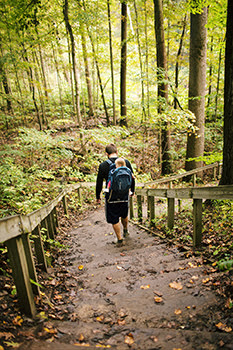 Michigan’s 20 million acres of forests include about 100 native conifer and broadleaf tree varieties adapted to thrive in a variety of soils and climates. Learn about a few of them on the Michigan Department of Natural Resources’ growing tree species webpage. Michigan’s 20 million acres of forests include about 100 native conifer and broadleaf tree varieties adapted to thrive in a variety of soils and climates. Learn about a few of them on the Michigan Department of Natural Resources’ growing tree species webpage.
Whether a tree grows on a sunny farm in the country, as part of a manicured suburban backyard or overlooking neon city lights from a pot on an urban balcony, it matters! Large or small, every tree provides an environmental benefit that improves the community it grows in.
Large expanses of state, national and private forests are important for many reasons. Older forests provide ideal habitat for deep-woods wildlife species like pine martens and spruce grouse. Younger forests are favored by woodland elk and wild turkeys. Dry, sandy jack pine forests that need fire to thrive are home to Kirtland’s warblers. Wetland forests, harboring cedar and willow trees that enjoy “wet feet,” are essential for waterfowl, fish and amphibians.
In addition to creating habitat, forests clean the water in lakes and streams, purify the air and provide renewable materials for products people use every day. Forests are also inspiring places for backcountry hiking, wildlife watching and exploring.
This doesn’t diminish the value of trees in urban settings – they’re critically important, too. Urban trees help bridge the gaps between larger expanses of natural areas. Each tree, shrub and native plant in a town or city is like a steppingstone for migrating songbirds, bees, butterflies and other wildlife as they flit and scurry about.
Trees in communities
|
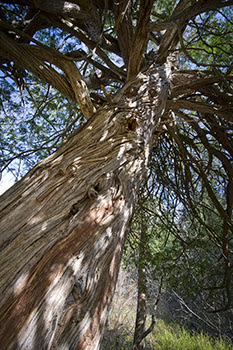 Trees provide wildlife with places for nesting, food and shelter. They also provide benefits to the human communities where they grow. Trees provide wildlife with places for nesting, food and shelter. They also provide benefits to the human communities where they grow.
Trees naturally perform a heavy lift that would be difficult and expensive to match by any human-made machine. They shade and cool cities from the sweltering effects of hot concrete and asphalt, soak up (through their roots) stormwater that can cause flooding and erosion, and boost air quality. For every 10% increase in urban tree canopy, lung-damaging ozone gas is reduced by 3% to 7%. Tree-lined streets have also been shown to reduce particles from car exhaust by as much as 60%.
Trees are also one of the easiest and most cost-effective ways to draw carbon dioxide out of the atmosphere. Michigan State University Extension reports that it takes about 1.5 pounds of carbon dioxide to grow a pound of wood in a tree. That carbon becomes part of the tree and eventually part of durable goods such as homes and furniture, made from sustainably harvested trees.
Need another reason to plant a tree? Mature, healthy trees can increase property values as much as 15%. Most people would agree that it’s way easier to plant a tree than start a kitchen remodeling project.
These benefits can be put into a tangible number using a tree value calculator such as My Tree from the USDA Forest Service. The My Tree calculator estimates a tree’s benefits in monetary terms from expected impacts on air pollution, carbon absorption and stormwater interception, among other categories.
For example, a 36-inch-diameter red maple in the Lansing area that receives full sun might bring a benefit equal to $330 in the next 20 years by absorbing about 13,500 pounds of carbon, intercepting nearly 30,000 gallons of rainfall and removing toxic gases like carbon monoxide, ozone and sulfur dioxide from the air we breathe. The value from the carbon the tree already had absorbed in its lifetime would equal nearly $900.
As exciting as it is to be able to put a tree’s value into monetary terms, the dollar doesn’t tell the whole story. It’s impossible to truly measure the joy a tree’s blooms can bring in the springtime after a long winter, or how special it is for a child to watch a family of robins hatch and fledge baby birds from a nest built in its branches.
Plant trees, grow community
|
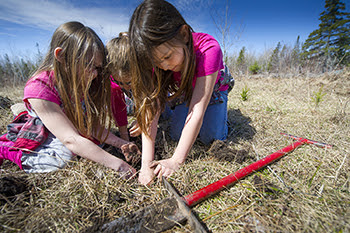 Ready to plant a tree? The most important consideration is “right tree, right place.” Not all trees need the same conditions to thrive. Put simply, a horse and a hamster are both pets, but you wouldn’t feed or house them the same way. The same goes for trees! A towering white pine might be a great fit for a sunny, open space, while a small, flowering redbud might be better suited to an area with power lines or partial shade. Ready to plant a tree? The most important consideration is “right tree, right place.” Not all trees need the same conditions to thrive. Put simply, a horse and a hamster are both pets, but you wouldn’t feed or house them the same way. The same goes for trees! A towering white pine might be a great fit for a sunny, open space, while a small, flowering redbud might be better suited to an area with power lines or partial shade.
Some things to consider before getting your shovel ready are:
- Growing zone.
- Soil conditions and moisture at the site.
- Wind and sun exposure.
- Infrastructure (avoid pipes and power lines – call 811 before you dig to have lines marked for free).
Tree-planting resources from the Arbor Day Foundation, which celebrates a milestone 150 years of Arbor Day in 2022, will help people pick the right species for their area with tools such as species profiles and how-to sheets. |
Note to editors: Contact: John Pepin, Showcasing the DNR series editor, 906-226-1352. Accompanying photos and a text-only version of this story are available below for download. Caption information follows. Credit Michigan Department of Natural Resources, unless otherwise noted.
Text-only version of this story.
Cedar: In addition to creating wildlife habitat, trees – like this cedar, near the Au Sable River in the northern Lower Peninsula – clean the water in lakes and streams, purify the air and provide renewable materials for products people use every day.
Fall: Michigan offers plenty of opportunities for popular outdoor pastimes like spotting fall foliage, with the state’s millions of acres of forests.
Giveaway: As part of a partnership with The Greening of Detroit and the Detroit Pistons, the Michigan Department of Natural Resources gave away 150 free trees – along with planting instructions and advice on picking the right tree for the planting location – during an event at the DNR Outdoor Adventure Center in Detroit in the fall of 2021.
Hike: Michigan’s forests are inspiring places for backcountry hiking, wildlife watching and exploring. Here, hikers enjoy an outing at Warren Woods State Park in Berrien County.
Planting: The Michigan Department of Natural Resources has pledged to plant 50 million trees in Michigan by 2030 as part of the global 1T.org Trillion Trees campaign. Here, elementary school students participate in a tree-planting day at the DNR Grouse Enhanced Management Site on Drummond Island in Chippewa County.
Sign: The Arbor Day Foundation celebrates a milestone 150 years of Arbor Day, which will be observed April 29 this year, in 2022.
Spruce grouse: Older forests provide ideal habitat for deep-woods wildlife species like pine martens and spruce grouse, pictured here.
Tree-NA: Michigan’s 20 million acres of forests include about 100 native conifer and broadleaf tree varieties. Learn about a few of them – like the eastern redbud, featured in this “Tree-NA” graphic – on the Michigan Department of Natural Resources website at Michigan.gov/DNR/Education. |


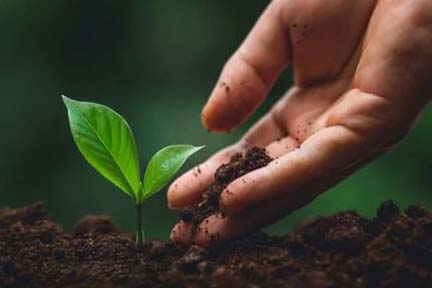
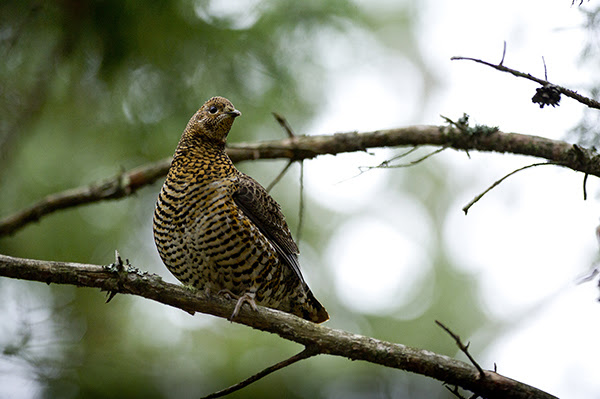
 Michigan’s 20 million acres of forests include about 100 native conifer and broadleaf tree varieties adapted to thrive in a variety of soils and climates. Learn about a few of them on the Michigan Department of Natural Resources’ growing
Michigan’s 20 million acres of forests include about 100 native conifer and broadleaf tree varieties adapted to thrive in a variety of soils and climates. Learn about a few of them on the Michigan Department of Natural Resources’ growing  Trees provide wildlife with places for nesting, food and shelter. They also provide benefits to the human communities where they grow.
Trees provide wildlife with places for nesting, food and shelter. They also provide benefits to the human communities where they grow.
 Ready to plant a tree? The most important consideration is “right tree, right place.” Not all trees need the same conditions to thrive. Put simply, a horse and a hamster are both pets, but you wouldn’t feed or house them the same way. The same goes for trees! A towering white pine might be a great fit for a sunny, open space, while a small, flowering redbud might be better suited to an area with power lines or partial shade.
Ready to plant a tree? The most important consideration is “right tree, right place.” Not all trees need the same conditions to thrive. Put simply, a horse and a hamster are both pets, but you wouldn’t feed or house them the same way. The same goes for trees! A towering white pine might be a great fit for a sunny, open space, while a small, flowering redbud might be better suited to an area with power lines or partial shade.
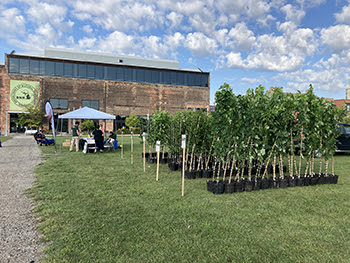 In addition to providing
In addition to providing